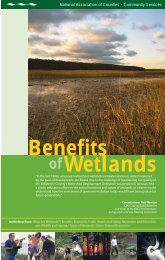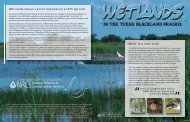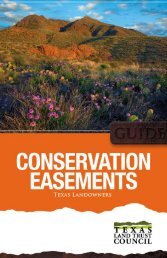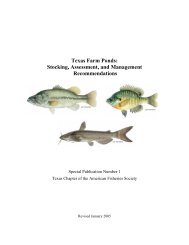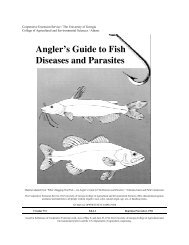Managing Yaupon with Fire and Herbicides in the ... - Trinity Waters
Managing Yaupon with Fire and Herbicides in the ... - Trinity Waters
Managing Yaupon with Fire and Herbicides in the ... - Trinity Waters
Create successful ePaper yourself
Turn your PDF publications into a flip-book with our unique Google optimized e-Paper software.
Sidebar<br />
The use of <strong>in</strong>dividual plant treatments (IPT) to control problem<br />
plants is becom<strong>in</strong>g an <strong>in</strong>creas<strong>in</strong>gly viable management<br />
alternative. 6 The suggested method for manag<strong>in</strong>g yaupon <strong>in</strong><br />
Texas is to apply an IPT of 25% Remedy (triclopyr: 3,5,6-<br />
trichloro-2-pyrid<strong>in</strong>yloxyacetic acid, butoxyethyl ester, 61.6%)<br />
<strong>in</strong> diesel fuel to wet completely around <strong>the</strong> lower 18 <strong>in</strong>ches<br />
of <strong>the</strong> trunk anytime dur<strong>in</strong>g <strong>the</strong> year. 7 However, little <strong>in</strong>formation<br />
is available for treatment options that <strong>in</strong>corporate prescribed<br />
burn<strong>in</strong>g. We <strong>in</strong>vestigated <strong>the</strong> impact of low-volume<br />
basal IPT of diesel <strong>and</strong> diesel comb<strong>in</strong>ed <strong>with</strong> Garlon 4 (triclopyr:<br />
3,5,6-trichloro-2-pyrid<strong>in</strong>yloxyacetic acid, butoxyethyl<br />
ester, 61.6%) at rates of 5%, 10%, 20%, <strong>and</strong> 25% on<br />
yaupon plants that had sprouted 6 <strong>and</strong> 18 months after prescribed<br />
burn<strong>in</strong>g. We used Garlon 4 because it is labeled for<br />
controll<strong>in</strong>g woody plants <strong>in</strong> forests <strong>and</strong> wildlife open<strong>in</strong>gs.<br />
The climate is moist subhumid, <strong>with</strong> annual precipitation of<br />
about 40 <strong>in</strong>ches <strong>and</strong> a 225-day grow<strong>in</strong>g season. 8<br />
Management units on Gus Engel<strong>in</strong>g WMA are typically<br />
burned every 3 years. We chose 2 study sites that were<br />
burned on ei<strong>the</strong>r February 15, 2000, or February 22, 2001.<br />
These areas allowed us to evaluate <strong>the</strong> use of herbicides 6 <strong>and</strong><br />
18 months after burn<strong>in</strong>g. Study sites were selected on <strong>the</strong><br />
basis of accessibility <strong>and</strong> <strong>the</strong> presence of an adequate yaupon<br />
density for evaluation. The soils on each site were dom<strong>in</strong>ated<br />
by s<strong>and</strong>y loams <strong>with</strong> slopes rang<strong>in</strong>g from 1% to 8%. 8<br />
Woody plants varied by site <strong>and</strong> <strong>in</strong>cluded post oak, s<strong>and</strong> jack<br />
oak, cedar elm, yaupon, hawthorn, dewberry, <strong>and</strong> greenbrier.<br />
At each of <strong>the</strong> burned sites, 25 yaupon plants were selected<br />
<strong>and</strong> r<strong>and</strong>omly marked for no treatment, treatment <strong>with</strong><br />
diesel only, or 5%, 10%, 20%, or 25% Garlon 4 <strong>in</strong> diesel. We<br />
Figure 2. The study was conducted on <strong>the</strong> Gus Engel<strong>in</strong>g Wildlife<br />
Management Area located <strong>in</strong> Anderson County near Palest<strong>in</strong>e, Texas.<br />
ma<strong>in</strong>ta<strong>in</strong>ed 4–6 feet between treated trees to ensure that different<br />
trees were treated. The 2000 (18 months postburn)<br />
<strong>and</strong> 2001 (6 months postburn) burned yaupon trees had to<br />
meet 2 criteria to be selected for study. First, it must have<br />
been top-killed by <strong>the</strong> fire, <strong>and</strong>, second, <strong>the</strong> sprouts had to be<br />
<strong>in</strong> <strong>the</strong> short-shoot (reproductive) growth stage. A backpack<br />
sprayer fitted <strong>with</strong> a flat-fan nozzle was used to spray <strong>the</strong><br />
basal portion of <strong>the</strong> plant, avoid<strong>in</strong>g <strong>the</strong> foliage (Fig. 3). All<br />
herbicide treatments were applied between July 16 <strong>and</strong> 20,<br />
2001. Mortality was evaluated 24 months after spray<strong>in</strong>g. All<br />
trees that had any new or liv<strong>in</strong>g leaves, new sprouts or stems,<br />
or pliable stems were considered liv<strong>in</strong>g, whereas all trees <strong>with</strong><br />
brittle stems <strong>and</strong> brown leaves were considered dead.<br />
Response to Treatments<br />
Previous observations on Gus Engel<strong>in</strong>g WMA <strong>in</strong>dicated that<br />
prescribed burn<strong>in</strong>g reduced <strong>the</strong> canopy of yaupon but did not<br />
cause mortality. However, when diesel or diesel mixed <strong>with</strong><br />
Garlon 4 was applied 6 <strong>and</strong> 18 months after burn<strong>in</strong>g, mortality<br />
did occur at high rates (Table 1). All treatments conta<strong>in</strong><strong>in</strong>g<br />
Garlon 4 resulted <strong>in</strong> at least 92% mortality.<br />
<strong>Yaupon</strong> sprouted vigorously after burn<strong>in</strong>g. Mortality due<br />
to burn<strong>in</strong>g was not evaluated s<strong>in</strong>ce <strong>in</strong>dividual trees were not<br />
marked prior to burn<strong>in</strong>g. However, yaupon has proven to be<br />
a persistent competitor for resources even after prescribed<br />
burn<strong>in</strong>g. Its strong sprout<strong>in</strong>g ability has limited <strong>the</strong> longterm<br />
control of mature plants by burn<strong>in</strong>g alone.<br />
Management Implications<br />
<strong>Yaupon</strong> is controlled <strong>with</strong> low concentrations of herbicide<br />
after prescribed burn<strong>in</strong>g. We suggest select<strong>in</strong>g <strong>the</strong> treatment<br />
on <strong>the</strong> basis of management objectives <strong>and</strong> cost. For example,<br />
to develop yaupon-free clear<strong>in</strong>gs <strong>with</strong><strong>in</strong> a forested management<br />
unit, spray<strong>in</strong>g <strong>the</strong> postfire sprouts <strong>with</strong> 10% Garlon 4 six<br />
months after burn<strong>in</strong>g resulted <strong>in</strong> 100% mortality <strong>and</strong> would<br />
cost $0.40/killed tree. If about 85% mortality is acceptable, a<br />
basal application of diesel 6 months after burn<strong>in</strong>g would<br />
reduce treatment costs to $0.20/killed tree <strong>and</strong> elim<strong>in</strong>ate <strong>the</strong><br />
need to purchase herbicides. Although apply<strong>in</strong>g 25% Garlon<br />
4 resulted <strong>in</strong> 100% mortality 6 <strong>and</strong> 18 months after burn<strong>in</strong>g,<br />
treatment cost <strong>in</strong>creases to $0.73/killed tree, more than 4<br />
times more expensive than diesel alone. It appears that apply<strong>in</strong>g<br />
herbicides <strong>with</strong> IPT 6 months after burn<strong>in</strong>g is slightly<br />
more effective than apply<strong>in</strong>g herbicides 18 months after burn<strong>in</strong>g.<br />
Plants treated 6 months after burn<strong>in</strong>g were smaller, <strong>and</strong><br />
some of <strong>the</strong> herbicide was likely applied to <strong>the</strong> foliage <strong>in</strong> addition<br />
to <strong>the</strong> plant bases, likely flood<strong>in</strong>g <strong>the</strong> plant system <strong>with</strong><br />
herbicide. Prescribed fire alone will not reduce yaupon density<br />
<strong>and</strong> restore <strong>the</strong> flora <strong>and</strong> fauna of <strong>the</strong> Post Oak Savannah.<br />
<strong>Yaupon</strong> can be readily controlled <strong>in</strong> most situations. We<br />
have provided several alternatives for manag<strong>in</strong>g yaupon after<br />
burn<strong>in</strong>g. Prescribed fire application at 5- to 7-year <strong>in</strong>tervals<br />
<strong>and</strong> monitor<strong>in</strong>g habitat to respond to yaupon <strong>in</strong>vasions early<br />
will reduce <strong>the</strong> negative effects of yaupon. If yaupon is permitted<br />
to become too dense before burn<strong>in</strong>g, grass production<br />
18 Rangel<strong>and</strong>s




